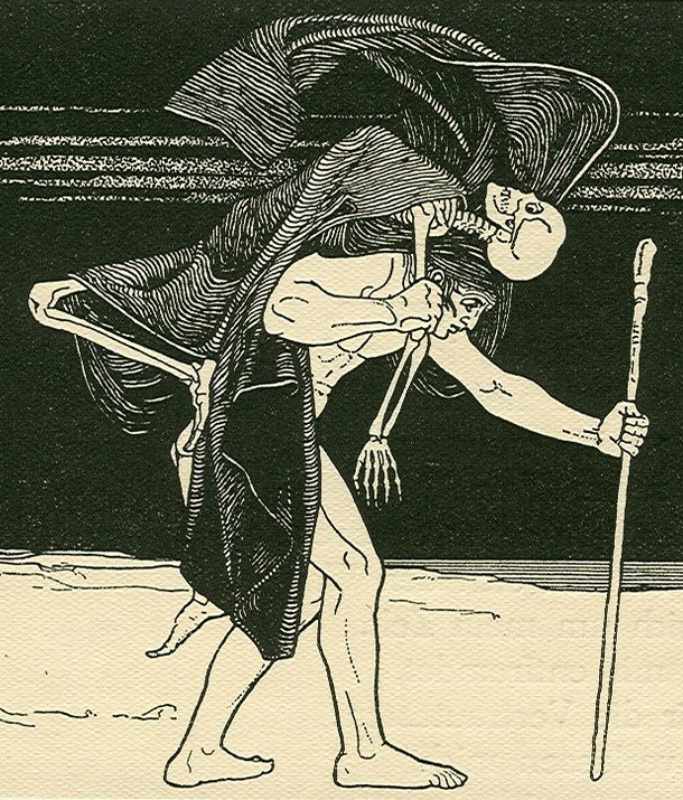In Jewish mythology, a dybbuk is a malicious possessing spirit believed to be the dislocated soul of a dead person. It supposedly leaves the host body once it has accomplished its goal, sometimes after being exorcised. The term first appears in a number of 16th-century writings, though it was ignored by mainstream scholarship until S. Ansky’s play The Dybbuk popularised the concept in literary circles. Earlier accounts of possession (such as that given by Josephus) were of demonic possession rather than that of ghosts. These accounts advocated orthodoxy among the populace as a preventative measure. For example, it was suggested that a sloppily made mezuzah or entertaining doubt about Moses’ crossing of the Red Sea opened one’s household to dybbuk possession. Very precise details of names and locations have been included in accounts of dybbuk. There are other forms of soul transmigration in Jewish mythology. In contrast to the dybbuk, the ibbur (meaning “impregnation”) is a positive possession, which happens when a righteous soul temporarily possesses a body. This is always done with consent, so that the soul can perform a mitzvah. The gilgul puts forth the idea that a soul must live through many lives before it gains the wisdom to rejoin with God.
| Alias Dybbuk, Dybuk |
| Real Names/Alt Names N/A |
| Characteristics Literary Characters, Paranormal Mysteries, Ghost, Invisibility, The Renaissance |
| Creators/Key Contributors ○ |
| First Appearance Jewish mythology |
| First Publisher ○ |
| Appearance List Kabbalistic Writings of Isaac Luria (16th century) and Sefer ha-Gilgulim (Book of Reincarnations, 16th century). First compilation of Luria’s teachings by Ḥayyim Vital is generally dated to c. 1590–1591 in Safed and Damascus, first printed Lurianic Kabbalah appeared in 1620 (Korets or Venice editions of Vital’s works). Ma’aseh Buch (Storybook of Jewish Tales, 1602), Shivhei ha-Ari (Praises of the Ari, 1620s), Sefer Nishmat Ḥayyim (Book of the Soul’s Life) by Menasseh ben Israel (1652), Shem ha-Gedolim (Names of the Great Ones) by Chaim Yosef David Azulai (1774–1786), The Dybbuk and Other Great Yiddish Plays (1966), In Romain Gary’s The Dance of Genghis Cohn (1967), A Psychoanalytic History of the Jews by Avner Falk (1996). Play: The Dybbuk by S. Ansky (1919; first staged 1920). Film: Dybuk (1937). |
| Sample Read The Best Plays of 1925-26 (1926) [Internet Archive] |
| Description In Jewish mythology, a dybbuk is a malicious possessing spirit believed to be the dislocated soul of a dead person. It supposedly leaves the host body once it has accomplished its goal, sometimes after being exorcised. The term first appears in a number of 16th-century writings, though it was ignored by mainstream scholarship until S. Ansky’s play The Dybbuk popularised the concept in literary circles. Earlier accounts of possession (such as that given by Josephus) were of demonic possession rather than that of ghosts. These accounts advocated orthodoxy among the populace as a preventative measure. For example, it was suggested that a sloppily made mezuzah or entertaining doubt about Moses’ crossing of the Red Sea opened one’s household to dybbuk possession. Very precise details of names and locations have been included in accounts of dybbuk. There are other forms of soul transmigration in Jewish mythology. In contrast to the dybbuk, the ibbur (meaning “impregnation”) is a positive possession, which happens when a righteous soul temporarily possesses a body. This is always done with consent, so that the soul can perform a mitzvah. The gilgul puts forth the idea that a soul must live through many lives before it gains the wisdom to rejoin with God. |
| Source Dybbuk – Wikipedia |

